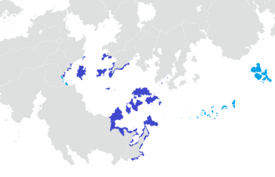Tahamaja Empire
Grand Thalassocracy of Tahamaja Tahamaja, Segara Telas | |||||||||||
|---|---|---|---|---|---|---|---|---|---|---|---|
| 782 CE–1353 CE | |||||||||||
|
Flag | |||||||||||
 The Tahamaja at its height, circa 1150 CE | |||||||||||
| Status | Former Empire | ||||||||||
| Common languages | Uthire | ||||||||||
| Religion | N'nhivara, traditional religions | ||||||||||
| Government | Thalassocracy | ||||||||||
| Pelautama | |||||||||||
• 782-823 CE | Yugah Mardanang | ||||||||||
• 824-865 CE | Garaj Ritarja Anukana | ||||||||||
• | ... | ||||||||||
• 1324-1353 CE | Tuminindyah Selangit | ||||||||||
| Sudasanan | |||||||||||
• 782-823 | Moestadja | ||||||||||
• 825-831 | Adjoikenang Melbama | ||||||||||
• 832-863 | Khoipan Irdokimojim Sukarnoputi | ||||||||||
| Historical era | The Great Expanse | ||||||||||
• Declaration of the 'Padwam Mena' | 782 CE | ||||||||||
• 'Asing Mesa' Declaration | 843 CE | ||||||||||
• Disestablished | 1353 CE | ||||||||||
| |||||||||||
| Today part of | Pulau Keramat, Onekawa-Nukanoa, Ayvana, Fahran | ||||||||||
The Tahamaja Empire, also known as The Grand Tahamaja, was a maritime empire that originated in archipelagic Malaio during the late 8th century with the formal Padwam Mena declaration by the first Pelautama(trans.First Captain) of the Tahamaja, Yugah Mardanang- who had unified the Solustheri Islands under a swift maritime campaign against the various, house based city-states that had formed. The Tahamaja existed as an extremely powerful naval and maritime influence throughout the Ozeros and Karaihe seas, with an exceptionally advanced standard of fleet standards and technological advancements to ensure maritime supremacy. Their control of trade through the Pulaui Archipelago gave access to most of South Ochran, West Scipia, and Malaio in a dominant set of trade settlement establishment and the bolstering of harbor-centered outposts. Being recognized as one of the largest diffusors of technology and exchange of cultural ideas and religions, such as the expansion of N'nhivara throughout it's borders, the Tahamaja eventually collapsed due to a set of internal conflicts exacerbated by disease and plague that was asserted to have been brought and contracted by traders within Norumbia, leading to the inevitable disarray of the Age of Fire.
